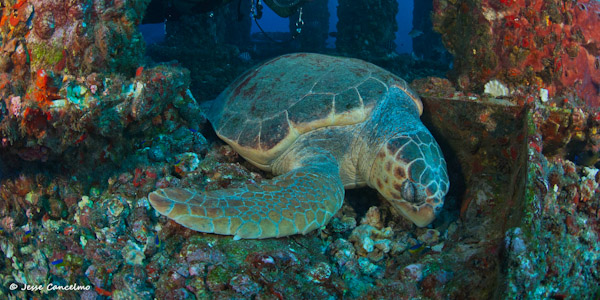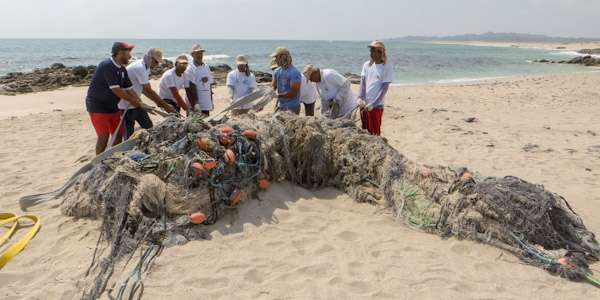All over the world, endangered female sea turtles are returning to the beaches where they were born to lay eggs of their own. Some females nest every year until the age of 80, and will return to the same nest even if they have not been there for 30 years! Although the survival rate for their babies, called hatchlings, is dismal — only one in 1,000 will survive to adulthood — there are aspects to the reproduction cycle of this ancient species that is still largely unknown yet awe-inspiring, and something we want to ensure future generations get to experience in their lifetimes.
 A loggerhead sea turtle sleeps on an offshore platform in the sanctuary. Photo by Jesse Cancelmo.
A loggerhead sea turtle sleeps on an offshore platform in the sanctuary. Photo by Jesse Cancelmo.
Proposed Rule Could Expand Marine Sanctuary
NOAA is currently accepting public input on a proposal to expand Flower Garden Banks National Marine Sanctuary, a deep coral ecosystem located 115 miles off the coasts of Texas and Louisiana that is one of just a handful known in the world. Data from the initial public review of the Draft Environmental Impact Statement (DEIS) in 2016 revealed almost 75% of the 8,491 comments favored expansion. Despite this, NOAA reduced the size of the expansion areas proposed in the 2016 DEIS preferred alternative to “minimize user conflicts and potential economic impacts to the offshore energy industry.” Big Oil must not be allowed to dictate the boundaries or protection status of a marine area of national significance. You can voice your support for the greatest possible expansion and protections of this special ecosystem by submitting a public comment by July 3.
California Agency: Protection for Leatherback Sea Turtles May Be Needed
The California Department of Fish and Wildlife recommended that Pacific leatherback sea turtles move toward protection under the state’s Endangered Species Act. The action came in response to a petition from Turtle Island Restoration Network. The Pacific leatherback population has declined by 90% over the past 40 years, mostly because longline and gillnet fishing for tuna and swordfish entangles and drowns these ancient, soft-shelled turtles. Scientists predict that, without help, Pacific leatherbacks could be extinct in 20 years. Protecting leatherbacks under the state’s Endangered Species Act would make them a state conservation priority. The state law would also provide a backstop to potentially weakened protections for leatherbacks under the federal Endangered Species Act.
Gulf Beaches Reopen as Sea Turtles Nest
After a volunteer with Turtle Island Restoration Network shared a video with us of a beachgoer in Surfside, Texas touching an endangered Kemp's ridley sea turtle, we wanted to remind community members and visitors to not disturb the animals if they are encountered and to report any sightings to local officials. Five endangered and threatened sea turtle species return to Gulf coast beaches from March to October each year to lay their nests. If a nesting sea turtle is on the beach during this time, it is important to keep your distance and not disturb the turtle. Give her 30 feet of space as she crawls to the dunes to nest, and as she returns to the water. Do not disturb the tracks or the nest cavity.
 Environment Society of Oman was awarded $5,000 to organize a dedicated net cleanup on Masirah Island.
Environment Society of Oman was awarded $5,000 to organize a dedicated net cleanup on Masirah Island.
Emergency Grant Protects Nesting Sea Turtles
Turtle Island Restoration Network teamed up with SEE Turtles this summer to hold a grant contest offering nonprofit organizations around the world emergency funds to support projects dedicated to protecting nesting sea turtles. Forty-five nonprofit organizations applied to receive the grant, and more than 30,000 individuals voted for the group they wanted to receive the funds. One $5,000 grant was awarded to the Environment Society of Oman for receiving the most votes. A second grant was given to Fundação Tartaruga, who was randomly selected to receive $1,000. Researching, protecting, and monitoring sea turtle nesting sites is a global top priority for sea turtle conservation, and we admire each organization's efforts to give these ancient species a fighting chance at survival around the globe.
TIRN Joins Dr. Sylvia Earle for a Virtual Roundtable
SPAWN’s Executive Director Todd Steiner recently joined Dr. Sylvia Earle, legendary oceanographer and founder of Mission Blue, for a conservation roundtable on what it will take to create the Cocos-Galapagos Swimway Hope Spot, a 120,000-kilometer underwater highway that will protect highly migratory endangered and threatened marine species like whale sharks, green sea turtles, silky sharks, and scalloped hammerhead sharks. The Cocos-Galapagos Swimway connects the National Parks of two sovereign nations – Costa Rica’s Cocos Island National Park with Ecuador’s Galapagos Marine Reserve – both of which are UNESCO World Heritage Sites.
Proposed Bill Would Ensure Sharks are Protected Under Wildlife Laws in Costa Rica
Turtle Island Restoration Network submitted a letter to the Legislative Assembly of the Republic of Costa Rica to support a bill that would return wildlife status to sharks in Costa Rica. As the result of a 2017 government regulation, sharks are currently considered a commercial species — rather than wildlife — and are not protected under the Wildlife Conservation Law. “With this proposal, Costa Rica can improve the protection of endangered species such as the silky shark, thresher shark and hammerhead shark,” the letter states.